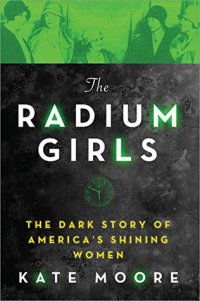 by Kate Moore
by Kate Moore
ISBN 9781492649359
With war raging in Europe, the demand for luminous watch dials and airplane instruments panels was voracious when Katherine Schaub began work the United States Radium Company’s dial painting studio in Orange, New Jersey in February 1917 at the age of fourteen. And when the United States joined the war only a few months later, demand exploded even further. Schaub would be only one of hundreds of young women who applied the patented luminous paint to the watch faces, dipping her brush into the radioactive material, and using her lips to point the brush for the finely detailed work of applying the paint to the numbers. She and her fellow dial painters had no idea that the miraculous element that caused them all to glow in the dark as they left work each night was slowly burrowing into their bones, with health consequences that would not be felt for years, long after many of the women had left dial painting behind. In The Radium Girls, Kate Moore chronicles the medical mystery that perplexed doctors and dentists for years, and the uphill legal battle that the women faced as they raced against their decaying bodies for acknowledgement of what their employers had done to them.
The problems began with their teeth. Terrible toothaches, and bleeding gums. Most dentists had never seen anything like it, and the ones that had thought their patients must be suffering phosphorous poisoning. But when the decaying teeth were pulled, the wounds they left behind did not heal, and the pain only grew worse. And that was just the beginning. One surprised dentist went to extract a dial painter’s tooth, and came away instead with a piece of her jawbone. Another accidentally broke a patient’s jaw simply by touching it. Moore chronicles all this in brutal detail, not sparing the reader the horrifying specifics of the terrible pain these women suffered in life, and the still more horrifying ways they finally met their ends. One of the earliest deaths Moore depicts is that of an Orange dial painter who drowned in her own blood after the radium ate away at her face and throat until her carotid artery gave way. Making the reality clear could not be described as gratuitous, but nor is this a book for the squeamish or faint of heart.
The Radium Girls features a very large cast of characters spread out between two different factories. The book opens in Orange, New Jersey, and then moves back and forth between Orange and Ottawa, Illinois. Moore has the unenviable struggle of trying to concisely portray a situation that was geographically distributed, and strung out over many years, as the companies involved concealed and denied their culpability for the women’s illnesses. The vast cast makes it difficult to get to know many of the women well. Grace Fryer and Katherine Schaub stand out in New Jersey, while Catherine Wolfe Donohue makes a strong impression from among the Illinois women. Fryer and Donohue were the backbones of the coalitions of former workers who sued their employers, while Schaub is notable for leaving behind extensive writings about her life and experiences. Many others are less documented, but suffered no less than their better remembered peers. The very nature of the tragedy Moore is trying to document is that many of these women did not live long enough to speak for themselves.
The narrative of The Radium Girls stretches over the more than twenty years it would take for the women to win any meaningful legal victory over their former employers. It is not a medical or legal or labour rights text, unlike the academic chronicles that have gone before, and on which Moore drew extensively, but all of these elements are present, and well explained for the general reader. Rather, Moore takes a more personal approach, focusing on the experiences of the women as far as they can be reconstructed. Moore is far from a dispassionate chronicler; she has a rage that is nearly incandescent as she cries out against the injustices these women suffered. She calls for their sacrifice to be given meaning, and for their suffering to be remembered, though they are gone. It is a fitting tribute, but one that can hardly make up for everything the women suffered.
___
You might also like The Girls of Atomic City by Denise Kiernan
Advertisements Share this:- History
- Non-Fiction





